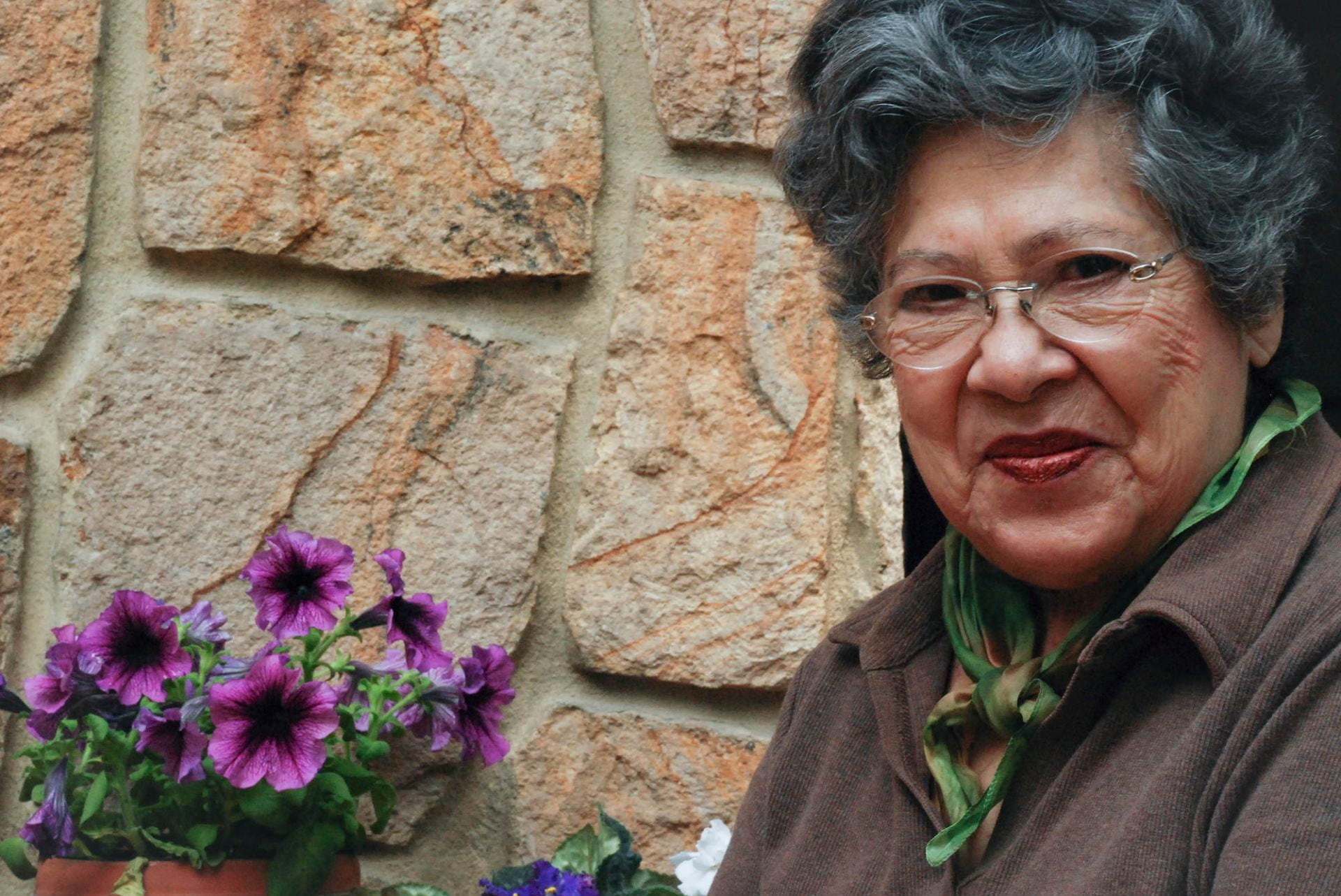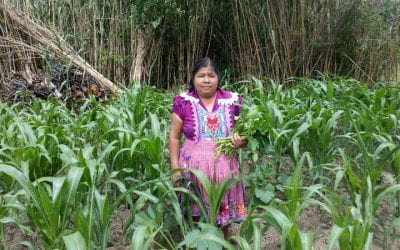A Shaky Social Protection System Spells Vulnerability
Growing Older in 21st-Century Peru
Photos by María Fernanda García Múnera
Calendaria Noya migrated when she was twenty years old from a small town of farmers and weavers in Cajamarca to the bustling metropolis of Lima. When I interviewed her in 2005 for my project on financial security in old age (Apuntes, vol 33, 2006), Noya told me how she had found employment as a live-in domestic worker in the upscale Miraflores neighborhood.
Noya worked mostly as a nanny, moving from household to household when her young charges grew up. When she turned 63, she completed retirement paperwork, and one year later, she began receiving the minimum public pension of $120 per month. When Noya was approaching seventy years of age, she quit her job as a domestic worker and moved in with her extended family in Lima´s northern cone of districts. She felt that she was too old and too sick to continue caring for new babies (at this stage in her life, the children of the children she helped raisedinitially).
At first glance, Noya’s story is not distinctive. Several hundreds of thousands of migrants moved from their rural homes into the city in hopes of a better life in the 1950s and 1960s. Their background was in subsistence farming; they had few years of formal education if any, and for the most part they worked in unskilled (or low-skill) jobs once they arrived. Most worked in diverse informal activities such as construction, commerce, repairs, transportation, domestic and other personal services. They often occupied land outside urban centers that slowly grew from precarious and haphazard villages to more developed settlements.
Over the next few decades, Peru and other Latin American countries followed import substitution strategies that promoted industrialization through protectionist and redistributive policies as well as large government bureaucracies. With the support of public investment, foreign debt and state-owned enterprises, policy makers—often populists— formulated “development from within” agendas.
In 1971, the Peruvian dictator General Velasco Alvarado, without any attention to financial sustainability considerations, expanded social security coverage to farmers, peasants, domestic workers and other low-income groups, along with their families. During her active career, Noya´semployers tapped into this opportunity and enrolled her in the now defunct Peruvian Social Security Institute (IPSS). Payroll contribution rates for domestic workers were very low and thus affordable.
A few years later, IPSS was actuarially broke. As a recent Ph.D. graduate in the mid 1980s, I assessed its finances and prospects with Carmelo Mesa Lago, a professor at the University of Pittsburgh (see his article in this issue). Our findings showed that several factors contributed to thesevere institutional crisis in the IPSS and to a sharp increase in the public pension debt. Among the causes, we found, were the expansion of coverage at unsustainably low payroll contribution rates (these types of payroll taxes targeted precisely those in Noya´s situation) and the generous benefits granted to special groups of workers (for example, “cédula viva” which gave pensions equal to salaries to government officials), in addition to administrative and financial mismanagement. Social security reform was unavoidable.
In the early 1990s, social security reform efforts were part of a sweeping structural transformationrecommended by international financial institutions and executed by another dictator, Alberto Fujimori. The institutional changes promoted greater reliance on the market through trade and financial deregulation, small government, foreign direct investment and safety nets for the poor.The latter were targeted through provision of food, health care and educational assistance, often in remote locations where public services and public assistance were scarce or absent.
IPSS was shut down. A new social security health care institution, EsSalud, now provides services to insured employees and their families, with payroll contributions paid by employers. In lieu of the old pension program, the Office of Pension Normalization (ONP) was created. It enrollsemployees and pays benefits to former IPSS pensioners such as Noya. ONP continues as a pay-as-you-go (PAYG), funded with payroll contributions from employees and public transfers.
With ONP now streamlined, the government created and encouraged affiliation to a new private pension system. The system was a copy of the Chilean public pension system, except that theChilean plan was closed to new affiliates while ONP is open to new affiliation. Private pension fund managers (AFP) administer the retirement savings of affiliated employees. A simplified version of the U.S. 401(k) retirement plans, it excludes, however, tax credits and is only funded with employee contributions. In contrast to ONP, a minimum pension guarantee does not exist—another difference with Chile—, and there are no solidarity transfers among affiliated employees.At retirement age of 65 (for both systems), AFP affiliates can purchase an annuity from insurance companies or make withdrawals until they exhaust their pension balance. Since 2017, AFP affiliates can cash in 95.5 percent of their total pension balance when they turn 65. If they don´t own a home, they can also withdraw, at any time, one quarter of their pension balance to help defray a home purchase.
Employees with registered labor contracts are mandated to make payroll contributions to ONP or AFP. In the public PAYG pillar, eligibility requires twenty years of contributions, and there are minimum and maximum caps for pensions. AFP pensions are determined by the employee´s pension balance. ONP is good for low-income earners, while AFP is suitable for medium- and high-income earners.
The Peruvian labor force is around 16 million people. Employees slightly outnumber self-employed workers who are often unregistered or informal. But only half of the total number of employees contribute to a pension system. This translates into one of the lowest labor force coverage rates in Latin America (Cruz Saco et. al, La desestructuración del sistema peruano de pensiones, Universidad del Pacífico, 2018). The flexibility of entry and exit from formal dependent jobs to unregistered self-employment, the large size of unregistered employment, excessive transaction costs—particularly in AFP—and low remunerations explain high evasion rates despite several attempts to make retirement savings more accessible. Some analysts add that most people prefer not to think about old age, and when the probability of detection is low, people have an incentive to evade to have more money to spend immediately.
In April 2016, I visited Noya to check on her and to gather additional insights for a co-authored book on aging (Cruz Saco et. al, El porvenir de la vejez. Demografía, empleo y ahorro, Universidad del Pacífico, 2018). She had just turned 91 and was living with her niece and family. Noya stayedbusy, visiting friends and relatives, watching soap operas and following Peruvian politics. She told me that she never missed a monthly medical appointment at EsSalud where she collected her medication for hypertension and cardiovascular disease.
Noya is one of 2.2 million older persons (65 and older) representing seven percent of Peru´s total population. However, a sharp decline in fertility rates and continuous increase in life expectancy is expected to lead to a rapid increase in that percentage. The low pension coverage, however, means that only 40 percent of this population earns a pension—28 percent public and 12 percent private (Situación de la población adulta mayor, INEI, 2018). Alarmingly, the proportion of older persons with a pension is projected to decrease. First, the cashing out as a lump sum pension at the moment of retirement may lead to personal decisions that will not produce a rent or pension in old age. Second, the steady increase in informality reduces coverage rates. And finally, not wanting to think about old age dissuades retirement savings and encourages evasion.
In 2011, the Peruvian government introduced a non-contributive or social pension. In contrast to the stated goals of neo-liberal policy makers, Carolina Trivelli, minister of development and social inclusion (MIDIS), created Pensión 65 to protect older persons who lacked basic resources. Pensión 65 is a bimonthly transfer of $72 to older persons who qualify as extremely poor. As of December 2018, with Pensión 65, the pension coverage of older persons increased from 40 to 66percent. This social pension represents only a fraction of the average monthly pension of the other two pillars: the average ONP pension is $194, AFP pension, $311 and Pensión 65, $36 (El Comercio, July 31, 2018).
Macroconsult, a Peruvian consulting firm, conducted an impact assessment of Pensión 65 (June2016). It found that more than half of the beneficiaries lacked any formal education and more than one third had not completed their primary education. For nearly half (45 percent) Quechua was their mother tongue, followed by Spanish with 40 percent, and 11 percent, Aymara. The proportion of Quechua and Aymara beneficiaries is much larger than its overall population participation (12 percent and 1.3 percent respectively). The study encountered that on average two persons lived with the beneficiary, and that 90 percent were insured by the public non-contributive health system (SIS). Most beneficiaries knew the eligibility conditions for the social pension and regarded the service as satisfactory, the study reported. It found that beneficiariesreceived their pension at an urban center with a Banco de la Nación or in a designated site where a payment truck would park (although payment sites were often a considerable distance from their residence). Almost all of the pension was spent in food that was shared with the family, and the well-being of the beneficiary had improved thanks to the benefit, the study concluded.
Innovations for Poverty Action (IPA), a U.S. based consulting firm headed by Dean Karlan of Northwestern University, conducted another assessment of the impact of Pensión 65 on the well-being of beneficiaries (August 2016). It found a nine percent reduction in the incidence of mental health outcomes (basically depression), a four percent reduction in remunerated jobs thanks to the transfer and a forty percent increase in household consumption. Elderly people did not have to resort to low-paid jobs or peddling water on the streets—a positive benefit for the older population. At the same time, the monetary subsidy was shared within the household whose consumption expenses increased. However, the study found that despite access to non-contributive public health insurance, beneficiaries´ access to health care services and health situations did not improve compared to the control group.
How does this affect Noya’s story moving forward?
First, Noya was indeed fortunate to have been employed in households that paid attention to the importance of insurance to cover health care and old-age. She is probably eligible for Pensión 65 because she is vulnerable, extremely poor, and lacks basic means to sustain herself. In addition, she is single and does not own any real estate or financial assets. Noya also fits the cultural characteristics of the average Pensión 65 beneficiary. Her background is indigenous, she is the daughter of farmers in the northeast Andean valleys, and she did not complete her primary education. At the end of the day, however, Noya did better than Pensión 65 because she earns the minimum public pension which is 3.3 times the social pension (and she also receives two additional payments for Independence Day in July and for Christmas).
Second, Noya´s health is satisfactorily cared for at EsSalud. Waiting time can be long but health providers are kind and listen to her, she says, and she has made her routine medical visits an opportunity to share time with other older persons. She has been operated on twice—a benign brain tumor when she was in her seventies and a hip replacement in her eighties—and in both cases, she recovered well and kept on with her active life. In this sense, her experience seems to differ from the IPA report.
Third, in Peru—as well as in other societies with similar shaky social protection systems for vulnerable people—the extended family, the community of friends and charitable organizations—will continue to provide meaningful informal support during old age. Noya would not be as happy or active if it weren´t because of her niece, her niece’s family and her large extended family that pays attention to her well-being.
But Noya’s story is different. Not everybody has the level of support that she has.
Pensions are clearly important although even in Noya’s case, totally insufficient to pay expenses. Thus, older persons’ income usually need to be supplemented or supported by family, relatives and friends. Growing old brings with it a variety of difficulties including mobility, chronic diseases such as Alzheimer’s, cardiovascular issues, diabetes, hypertension and Parkinson’s. Often, additional resources are needed for caregiving. The sad truth is that not every one´s family is supportive. In a poor country like Peru, that is growing older and not getting any richer, these issues will have to be resolved one way or the other.
Winter 2019, Volume XVIII, Number 2
Maria Amparo Cruz-Saco is the Joanne Toor Cummings ’50 Professor of Economics at Connecticut College and Visiting Professor of Economics at Universidad del Pacifico in Lima (Peru). She is co-author of El Porvenir de la Vejez: Demografía, Empleo y Ahorro (2018) and La Desestructuración del Sistema Peruano de Pensiones (2018), and has published extensively on social protection, aging and remittance behavior–among Hispanics in the United States–and on macroeconomic theory and practice. Contact information: macru@concoll.edu and macruzsaco@gmail.com.
Related Articles
Video Interview with Flavia Piovesan
Flavia Piovesan is a member of the Inter-American Commission on Human Rights, Professor of Law at the Pontifical Catholic University of São Paulo and 2018 Lemann Visiting Scholar at the…
Aging: Editor’s Letter
There is no smell of pungent printers ink permeating my office. My interns—Sylvie, Isaac and Marc—are not scrambling to find FedEx boxes to send out ReVista issues to authors and photographers all over the world. I cannot feel the silken touch of the printed page…
A Story of Agricultural Change
Francisca Hernández García, 92, lives in San Miguel del Valle, a town of around 3,000 inhabitants in the Central Valleys of Oaxaca, an hour east of the capital city. She is one of the few remaining…







